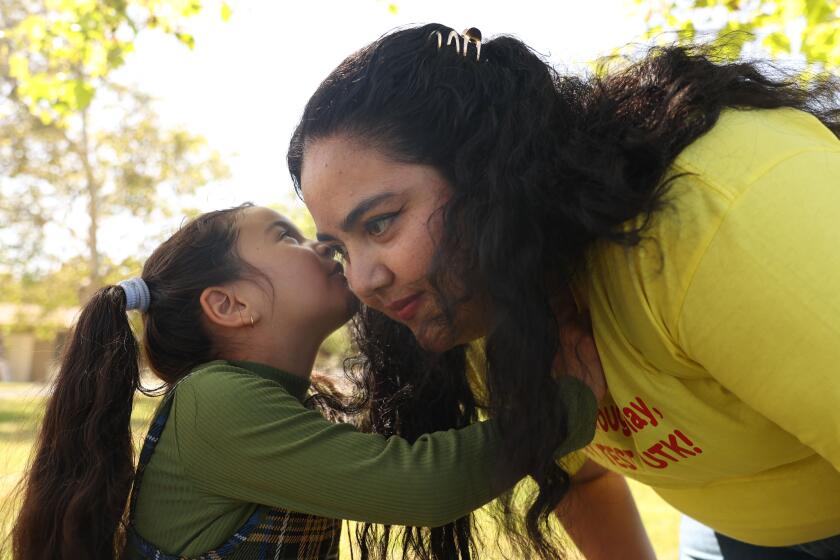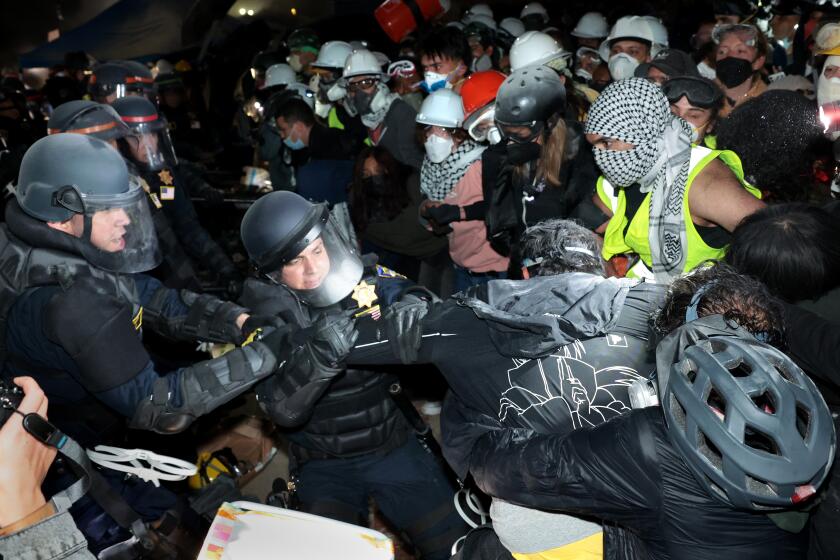Valley Perspective : Teachers Read Signals in Varied Clothing : Attire may tell school personnel they should step in to help because a student is leaning toward drugs or gangs.
A number of our educational leaders and politicians, including President Clinton, have embraced the concept of uniforms for public school students. The media have bombarded us with testimonials from principals who rave about the immediate impact at their schools. We hear statistics concerning reduction of the number of batteries, armed robberies and aggravated assaults. Perhaps in a school that is out of control, uniforms are a temporary remedy. However, in my 20 years of experience as an administrator, seven of which were in inner-city Los Angeles, I never saw or heard of a school that was in that condition.
Although I do not support uniforms, I do endorse a strictly enforced dress code that prohibits the wearing of any apparel that detracts from the educational program or endangers a child.
The wearing of uniforms has great appeal to educators because it is much easier to enforce than a dress code and acts as an equalizer by not placing students of parents who have less money at a disadvantage. In addition, use of uniforms can, under some conditions, reduce violence at school. Nevertheless, there are drawbacks.
One of my greatest difficulties with a uniform policy is that the actions of a very small percentage of children determine how the majority should dress. Why do school leaders not concentrate on the small number of students who are creating the problems? Why should more than 95% of the students have to react to the actions of less than 5%? It just does not make sense.
As a middle school principal, it is my duty to determine which children are in danger and to implement an intervention program. At Millikan, the decisions a child makes regarding clothing often serve as a barometer. It’s a red flag that tells school personnel that a particular child may need additional attention. Sometimes a change in style is strictly a harmless expression of individuality; however, often it’s the first sign that a child may be using drugs, may have become interested in a gang or be suffering from economic problems.
Our experience clearly shows that early intervention techniques have had a significant effect in reducing the number of students using drugs and joining gangs. In addition, children unable to afford clothing are offered jobs such as tutoring or cleaning the campus, rather than charity. This year we have discovered five cases of sexual abuse of girls, expressly as a result of taking note of the provocative clothing they had begun to wear. If these students had been wearing uniforms, we would not have discovered that they were having difficulty, and as a result we would not have implemented an intervention program.
As school officials, it is shortsighted for us to just wrap our children in pretty packages. What are schools going to do to determine which students need help? Children, under most conditions, are not running into the counselor’s office requesting assistance. In addition, these children spend a great deal of time in their communities. If parents are too busy or too preoccupied or suffer from a feeling of powerlessness, who will advise these children on proper dress?
A dress code is a living document that is revisited by staff, parents and students twice a year. In contrast, a uniform is a specific mode of dress adopted by adults and applied to children. One of the most important things we teach our children is self-discipline. As educators, our role is to set parameters for expected behavior. Our assumption is that when students understand the options, they will make the proper decision within the given limits. In contrast to the armed services, which use uniforms as a means of reducing individuality, I believe that the school should attempt to take advantage of student differences. It is quite clear that students learn, think and feel differently; therefore, why not let them dress differently? Why not allow a child to express himself with the clothing he chooses, as long as the mode of dress falls within the agreed-upon parameters?
The program works at Millikan because our teaching staff is composed of competent educators, trained in guidance techniques, sensitive to the needs of children, acutely aware of change and cognizant of student intervention methods. In addition, students follow the dress code because they have had input in the decisions.
There is no question that when staff, parents and teachers are cooperating, the dress code is far superior to uniforms. However, it is much more difficult to enforce than the uniform, because defining what clothing detracts from the educational program, or what apparel endangers a child, may not be a simple task. The uniform is a quick fix, and may be better than nothing if you are in a school where the stakeholders have divergent interests and goals, or have no time to talk with each other.
Applying Band-Aids to a problem, however, is a temporary solution that will ultimately fail when the child starts hemorrhaging. Concentrating on symptoms rather than causes may make the school look a little better, but it will not change the child. Uniforms give us a myopic picture of students who all look OK. In reality, we know many are not doing well. As principals, our goal is not only to make students look good, but also to make certain we have done all we can to identify and assist those who are having difficulty.
More to Read
Start your day right
Sign up for Essential California for news, features and recommendations from the L.A. Times and beyond in your inbox six days a week.
You may occasionally receive promotional content from the Los Angeles Times.






